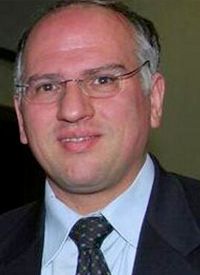Survival Gain With Higher Ipilimumab Dose Offers Opportunity for Some Melanoma Patients
Patients with stage III or IV melanoma assigned to 10 mg/kg ipilimumab (Yervoy) lived longer than patients assigned to a lower dose of the anti-CTLA-4 anticlonal antibody, but at the cost of greater toxicity.
Paolo A. Ascierto, MD

Paolo A. Ascierto, MD
Patients with stage III or IV melanoma assigned to 10 mg/kg ipilimumab (Yervoy) lived longer than patients assigned to a lower dose of the anti-CTLA-4 anticlonal antibody, but at the cost of greater toxicity.1
In results from a randomized, double-blind, phase III study performed at 87 medical centers in 21 countries, researchers found that median overall survival (OS) for 364 patients receiving 10 mg/kg of ipilimumab was 15.7 months compared with 11.5 months for 362 patients assigned to 3 mg/kg of ipilimumab (HR = 0.84; 95% CI, 0.70-0.99; P = 0.04).
However, patients in the 10 mg/kg group had a higher incidence of grade 3/4 treatment-related adverse events (AEs), including diarrhea (10% vs 6%), colitis (5% vs 2%), increased alanine aminotransferase (3% vs 1%), and hypophysitis (3% vs 2%).
Lead author Paolo A. Ascierto, MD, told OncLive that, at least in some patients, improved outcomes outweigh the risk for increased toxicity.
“In the era of anti—PD-1s and the combination of ipilimumab/nivolumab [Opdivo], there is no role for ipilimumab in first-line treatment of advanced melanoma because such treatments showed a better outcome than ipilimumab monotherapy,” he said. “However, ipilimumab might have a role in patients refractory to a first-line immunotherapy—for instance, BRAF wild-type patients who progressed after an anti—PD-1 treatment.
“With ipilimumab, with only 4 cycles, we have still the possibility to reach a long-term benefit. If it’s true that with 10 mg/kg we have a higher incidence of severe adverse events than with a lower dosage [37% vs 18%], it’s true as well that in refractory patients, where we have no other options to get a long-term benefit, this is superior to the risks.”
Researchers enrolled adult patients with histologically or cytologically confirmed unresectable stage III or IV melanoma from February 2012 to July 2012. Eligible patients could have been treated previously, as long as they had not received BRAF inhibitors, CTLA-4 or PD-1 antagonists, or PD-L1 or CD137 agonists. Patients who had been treated previously were required to undergo a washout period of 4 weeks for all previous anticancer therapy and of at least 2 years for systemic immunosuppressive drugs, except for episodic low-dose corticosteroids.
At a minimum follow-up of 43 months, patients in the 10 mg/kg group received a median of 4 doses of ipilimumab in the initial treatment phase, with 58% of patients completing all 4 doses. Patients in the 3 mg/kg group also received a median of 4 doses and 67% completed all 4 doses.
At the data cutoff of March 2016, 6% of patients in the 10 mg/kg group and 9% of patients in the 3 mg/kg group entered the first retreatment phase.
In the initial treatment phase, disease progression and treatment-related adverse events (AEs) were the most common reasons for discontinuation in both treatment groups. Patients in the 3 mg/kg group were more like to experience progression (43% vs 30%), but patients in the 10 mg/kg group were more likely to leave the study due to treatment-related AEs (24% vs 10%).
About one-third (36%) of patients in the 10 mg/kg group proceeded to systemic therapy, including 16% who underwent subsequent immunotherapy (16%) and 10% who proceeded to targeted therapy. The numbers were similar for patients in the 3 mg/kg group; 38% proceeded to systemic therapy, including 14% who received immunotherapy and 13% who had targeted therapy.
Researchers found that a similar proportion of patients with BRAF-positive tumors received subsequent therapy in both dose groups, 54% (43 of 80 patients) in the 10 mg/kg group versus 59% (47 of 79 patients) in the 3 mg/kg group. Patients in the 10 mg/kg group were more likely to receive subsequent anti—PD-1 therapy (19% vs 10%).
Post-hoc analyses showed that patients in both groups who received subsequent immunotherapy, primarily anti—PD-1, had better OS than those who received BRAF and MEK inhibitors or chemotherapy.
Writing in an accompanying editorial, Alexander Menzies, MD, PhD, and Georgina V. Long, PhD, MBBS, both with Melanoma Institute Australia, University of Sydney, argued that AEs are less of a concern compared with survival.2
“The best chance of long-term survival (>5 years) might require higher doses of ipilimumab. In an era of increased awareness and prompt management of (predominantly reversible) immunotherapy toxicity, improvements in efficacy might outweigh additional toxicity,” they wrote. “We have yet to reach a point where we are curing most patients with metastatic melanoma. Anti—CTLA-4 therapy is important in achieving this, and this study by Ascierto and colleagues suggests that dosing is important too. Further research is needed, not only into novel targets and combinations, but also into optimum dosing of anti–CTLA-4 in combination.”
References
- Ascierto PA, Del Vecchio M, Robert C, et al. Ipilimumab 10 mg/kg versus ipilimumab 3 mg/kg in patients with unresectable or metastatic melanoma: a randomised, double-blind, multicentre, phase 3 trial. Lancet Oncol. doi: 10.1016/S1470-2045(17)30231-0.
- Menzies AM, Long GV. Optimum dosing of ipilimumab in melanoma: too little, too late? Lancet Oncol. doi: 10.1016/S1470-2045(17)30228-0.



